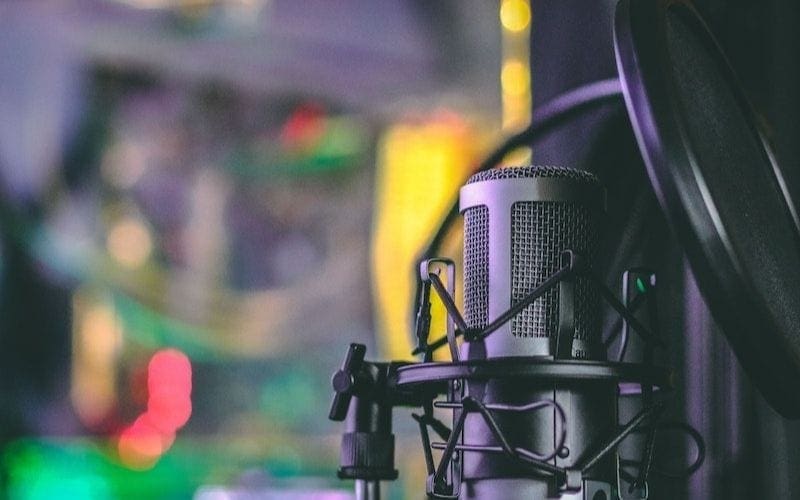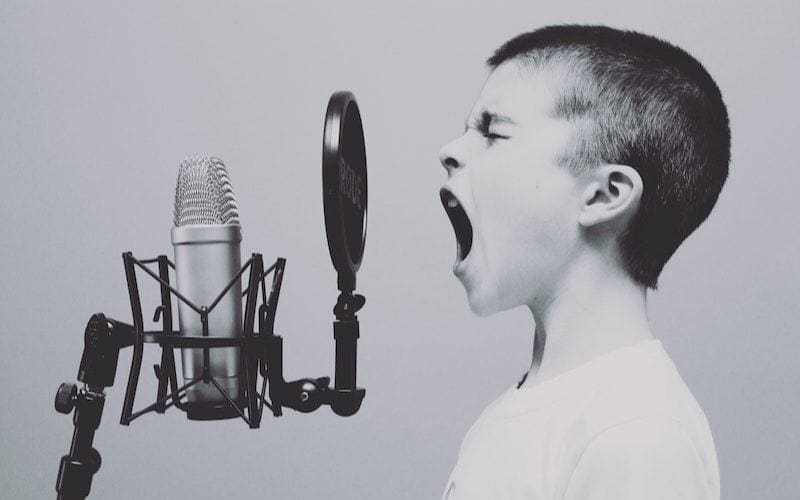You will have heard microphones making loud popping or banging sounds, unlike when we hear people speak normally and you’re probably wondering how we can avoid them, especially when in a studio recording session. This is where your microphone pop filters aka pop shield or pop screen come in handy. Mic Pop filters are crucial for any modern studio, but what are they and why are they so essential?
What Is A Pop Filter

So, what is a pop filter? Pop filters help the clarity of your vocal recordings.
Plosives are powerful P sounds that happen in words such as ‘pop’. These sounds are directional and could exceed the input capacity of your microphone which causes clipping.
What Does A Pop Filter Do?
With a pop filter, it will help to protect the microphone and is usually used in a recording studio. You’ll see circular nylon-mesh screens that clip to the mic stand and sit a couple of inches in front of the mic. It helps to eradicate popping noises that are created by the mechanical impact of quickly moving air on the microphone throughout recorded speech and singing. Even the most controlled singers will occasionally get the microphone popping.
The way it works is simple and luckily, the fabric layers on the pop filter help to shield the microphone from ‘pop’ as the sound passes through the fine mesh, reducing high-frequency and stopping plosives. The filter also helps to protect the microphone from saliva which could cause mic damage.
How To Use A Pop Filter

To use the filter, you first need to adjust the clamp to an open state and figure out how to secure the pop filter to the stand. Once you have the perfect position all you need to do is tighten the screw.
Then, alter the gooseneck. Position the pop filter close to, but not touching, the microphone. Position the microphone and pop the filter to 10 o’clock or 2 o’clock. This helps to prevent plosive sounds. Between 2- and 6-inches distance between the microphone and the filter will be satisfactory.
Next, record your vocals as normal, after the initial set up you shouldn’t need to tailor the filter during recording. Once you’ve got your vocals recorded, take down the filter and wipe it down gently with a cloth. This will remove any excess moisture that has built up.
Best Microphone Pop Filters
Here are just a few of the most highly recommended Pop Filters.
Nady MPF-6
The Nady MPF-6 is the best-selling and most widely known mic pop filter. It is very cheap but doesn’t fail to deliver what it promises! Although it is great value for money, you do get what you pay for so check out some other options below.
Price: £5.99
On-Stage Stands ASFSS6GB Dual-Screen
In comparison to the Nady MPF-6, the On-Stage Stands ASFSS6GB has one main difference. Instead of using only one screen to block plosive sound, it has two. The first screen blocks air blasts like any mic pop filter should. The gap in between then disperses any remaining air pressure, so by the time it reaches the second screen, the blast is easily contained. A double layer means double protection. Although some think, two-screen pop filters can block too much high frequency, reviews show ASFSS6GB does not have this problem, this is one of the best pop filters on the market.
Price: £27.80
Stedman Corporation Proscreen XL
Pop filters come in two standard designs, the cheaper nylon screens and the pricier metal screens. Nylon can tear and isn’t the easiest to clean which is why the metal pop filter is preferred. Stedman Corporation Proscreen XL has a unique patented material.
It has a different approach so rather than just blocking plosive sounds, the Proscreen XL uses angled slots in the filter to redirect the energy downwards, away from your microphone. It is a good mix of quality and affordability.
Price: £62.40
Avantone PS-1 PRO-SHIELD
Rather than the standard hoop designs, the Avantone PS-1 takes another approach. It has been designed to wrap around the microphone grill, instead of sitting out in front, where it’s likely to get knocked. It also eliminates the issue of singers having to readjust it which can put added wear and tear on the gooseneck. Similar to the Proscreen XL, the PS-1 has a hard screen which has better durability.
Price: £25.98
WindTech PopGuard 2000
The WindTech PopGuard 2000 wraps securely around the microphone, by mounting to the grill itself, instead of requiring an external gooseneck to hold it in position. With this design, it has the advantage of taking up very little space. Once it’s mounted, you forget it’s even there. However, you won’t be able to alter the distance between the screen and microphone and although it does fit on many large-diaphragm condenser mics, it, unfortunately, can’t fit on all of them, and it won’t fit on most dynamic mics.
Price: £19.80
Blue Microphones The Pop
You are probably aware of the Blue Microphones company who make blue yeti and the blue snowball. The brand makes everything from high-end tube mics to budget USB mics. Their signature pop filter is simply named ‘The Pop’. It is the most attractive and classiest-looking pop filter on the mic on the list. It isn’t only for Blue Microphones, just like other standard pop filters, it has a gooseneck and a clip that attaches to the mic stand. The main advantage of this is that it has a strong metal frame, wire mesh grill, extra-sturdy gooseneck and it also offers durability.
Price: £69.99
Pauly Ton Pauly Superscreen
We have looked at some high-end filters with some pretty expensive price tags but that is nothing in comparison to Pauly Ton Pauly Superscreen.
You may be thinking that this is out of the question but some people will spend that much on a filter even when there are plenty of good options for around £20. For this item, the reviews agree it is worth it! The level of transparency gained by this special screen is very impressive. It isn’t recommended for the average home studio but for those of you looking for the very best and willing to pay, Pauly Ton Pauly Superscreen is worth taking a look.
Price: £152.00
How To Make A Cheap Mic Pop Filter

There’s nothing magic about a filter and you can even make one for yourself, follow the step-by-step plan for a homemade pop filter:
What you need:
· A coat hanger
· Nylon tights
· Pilers
· Clamps
1. Create a circle by bending the wire coat hanger. Pull the triangle part of the hanger down. You will have something square-shaped. It doesn’t need to be perfect but keep pulling on the flat sides to create a more circular shape. If you’re struggling, try using a pair of pliers for a better grip.
2. Pull the pair of tights over the circle hanger. Pull them as tight as possible to get a flat, drum-like surface. Gather the extra slack around the hanger’s hook. Use tape or a rubber band to hold it in place.
3. Put the filter right in front of the mic about an inch or two away from the mic, without it touching it. It should sit between your mouth and the mic as you are recording. There isn’t a correct way to do this but some options include using a clamp to hold the filter to the stand. You can also use small, cheap clamps. Alternatively, you can tape the filter to a second mic stand and position this in front of the first.
4. You are now ready to record, just sing or talk through the filter into your mic. Switch on your recording equipment. Stand or sit so you make sure that the filter is in the middle of you and the mic. Your mouth should be just a few inches away from the filter.
Summary
A pop filter has many benefits. They make the sound clarity better, prevent pops, hisses, and lisps as well as ensure saliva doesn’t get all over your mic. They are also very easy to use and many are affordable!
Consider the microphone you use, as many condenser types require the use of a pop filter. However, a lot of vocal dynamic microphones already have pop filters built into the cone. Meaning you don’t need a pop filter if you are recording using a vocal dynamic one.
Pop filters are an effective means against nasty pops. Although experienced singers may not need to use a screen due to their good mic technique, using one does make life easier. Singers can concentrate on their performance instead of watching their Producers, and sound engineers can focus on getting great sounds and optimal levels.
In this guide, we have looked at some of the top microphone pop filters within a variety of price ranges. The list enables you to collect all the information you need to make an informed decision before you make a purchase!











